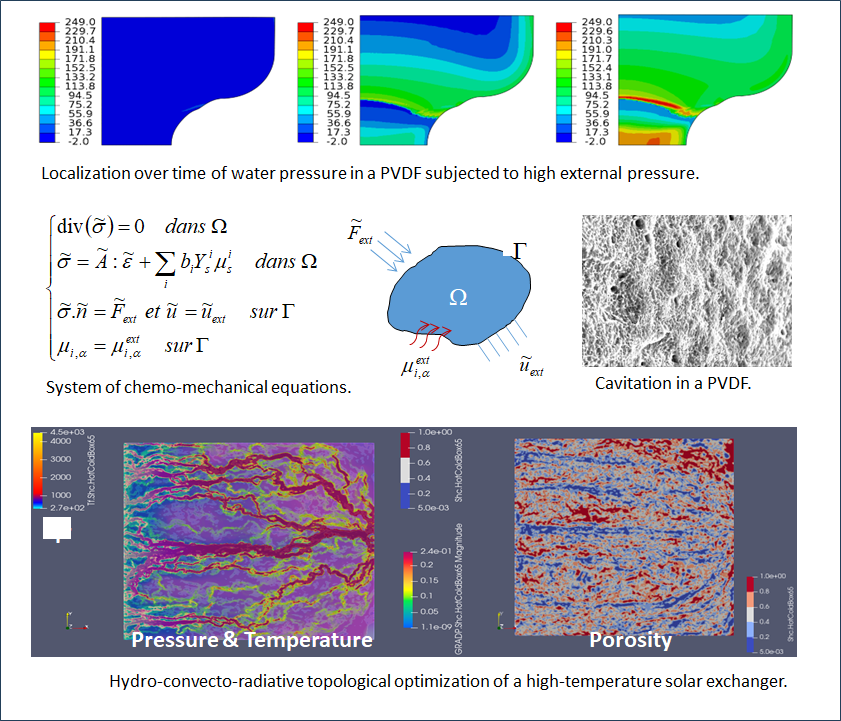
| Contribution to the study of couplings in interfaces, polymers and porous materials |
The work conduced within the context of my HDR (accreditation to direct research) relates to the field of modeling and concerns the formulation of multiphysical couplings in materials. The starting point for this research related to an industrial damage problem: cavitation caused by the explosive decompression of dissolved gases in the polymers used to seal flexible underwater pipes. By extension, it applies to all porous media exposed to the effects of mass transfer, heat, plasticity or damage, such as catalyst supports or natural underground environments.
Within this context, some couplings between plasticity and damage were also examined from different angles: a two-phase viscoplastic approach and cohesive zones1.
The general approach I followed consisted in adopting the theoretical framework of the Thermodynamics of Irreversible Processes (TIP)2 in order to deduce coupled behavior laws that are consistent with the fundamental principles of thermodynamics. The findings are the result of close collaboration with academic partners3.
This approach shed light on existing coupling processes between mass transfers and deformation and damage phenomena in semi-crystalline polymers4 [1,2]. More specifically, the mixed Fickian and Darcean nature of these transfers induces internal stresses that can generate localized cavitation phenomena that are seemingly counter-intuitive (the material being in a state of compression). Figure 1 illustrates an example of cavitation obtained in a Polyvynilidene fluoride (PVDF) polymer exposed to high external water pressure.
Beyond this example, the theoretical framework obtained makes it possible to propose an explicit form for a chemo-mechanical constraint, by introducing chemical potential as the main driving force behind the couplings. This formulation can, for example, be extended to the description of sorption laws in nano-confined porous media (such as zeolites5) or to dendrite growth in solid electrolyte batteries. On this latter theme, research is underway to adapt the model's formalism to the presence of electric fields and electrochemical phenomena.
The approach was recently used to develop new porous material architectures via topological optimization [3] and we plan to deploy it for the case of concentrating solar heat exchangers for energy-intensive processes or for solar fuel production (see Figure 1). A further future application involves the design of optimized magnets to increase the efficiency of electric machines.

1 Cohesive zone formalism enables the mechanical behavior of interface discontinuities between two media with different properties to be considered through displacement jumps
2 Unlike “conventional” thermodynamics (reversible transformations), the framework makes it possible to describe out-of-equilibrium systems that evolve through a sequence of equilibrium states.
3 Particularly Institut P’ and Poitiers University
4 Crystalline aluminosilicates of interest for the manufacture of catalyst supports
References :
- C. Baudet · J.-C. Grandidier · L. Cangémi (2011). A damage model for the blistering of polyvinylidene fluoride subjected to carbon dioxide decompression. Journal of the Mechanics and Physics of Solids 09/2011; 59(9):1909-1926
>> https://doi.org/10.1016/j.jmps.2011.04.010
- Castro-Lopez, C., "Modélisation du comportement diffuso-mécanique d’un polymère semi-cristallin sous pression d’eau", PhD thesis from the University of Poitiers, defended on September 11, 2015
- G. O. Agyekum, L. Cangémi and François Jouve (2022). Homogenization based topology optimization of fluid-pressure loaded structures using the Biot–Darcy Model. Optim Eng 25, 459–490 (2024)
>> https://doi.org/10.1007/s11081-023-09811-1
To contact : Laurent Cangémi





